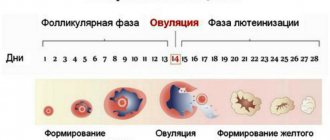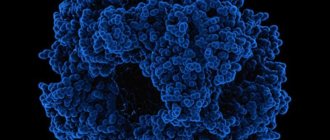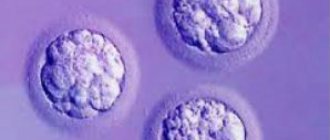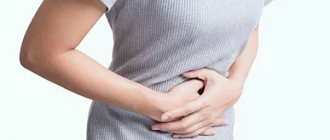Why is ovulation so important for pregnancy planning?
First, let's figure out what ovulation is. This is the moment when the egg leaves the ovary and enters the fallopian tube, after which it becomes available to sperm. The egg lives for approximately 24 hours, and then the fertilization window closes. Thus, during the entire menstrual cycle there is only one day during which a woman can conceive a child.
You may have heard from your friends that they got pregnant on a day when there were no symptoms or signs of ovulation. They are mistaken in their feelings: without a living and accessible egg, fertilization is impossible in principle. But there are nuances. First, sex that will cause pregnancy does not have to happen on the day of ovulation. Sperm that reach the cervix or overcome this barrier remain viable for up to three, sometimes five days. This means they can wait for the egg to "come out of the house." Secondly, the day of ovulation may not occur in the middle of the cycle, but earlier or later due to the individual characteristics of the body, hormonal changes, stress and other reasons.
Ovulation: the day of the cycle when the egg is ready to be fertilized
The process occurs at intervals of 21–35 days, depending on the length of the menstrual cycle, approximately in its middle. As a rule, menstruation occurs 12–16 (on average 14) days after ovulation.
Ovulation: symptoms that indicate readiness to conceive
In the middle of the menstrual cycle, ovulation occurs, the symptoms of which can be weak or pronounced depending on the individual characteristics of the body:
1) painful sensations in the lower abdomen;
2) sexual desire increases;
3) more mucus is released in the cervix;
4) the color of the discharge may change.
1. Pain during ovulation
Not all women experience pain during or after ovulation. According to statistics, pain is observed in only one in five women. You can feel pain during ovulation due to slight bleeding: the follicle bursts, and, in addition to the egg, follicular fluid comes out of it, as well as small blood clots.
- Mild pain during ovulation is normal.
During ovulation, the lower abdomen hurts - where the ovaries are located. The pain may be cutting, stabbing or cramping. Duration is about an hour, but for some women it lasts a day or two. If pain during ovulation is severe, tell your gynecologist.
The ovaries work alternately: in one month the follicle matures in the right ovary, in another month in the left ovary. For this reason, pain during ovulation is usually felt either on the right or on the left.
Gynecologists explain pain during ovulation by saying that the Graafian vesicle stretches the walls of the ovary. Also, pain during ovulation is associated with the fact that fluid flows out of the burst follicle. It stimulates contractions of the uterus and fallopian tubes, which causes pain during ovulation.
- Pain after ovulation is not that common.
If signs of ovulation bother you, consult a specialist. Pain after ovulation, for example a week before your period, may be a sign of ovarian inflammation or other problems with the reproductive system. Pain during ovulation, before or after it, is not necessarily associated with the release of an egg: most gynecological diseases are accompanied by pain of varying nature and intensity.
2. Increased sex drive
Pain during ovulation has little effect on sexuality: for many, sexual desire even increases. Nature itself tells you: ovulation has begun and conception is now most likely.
3. Discharge during ovulation
If you are interested in how to determine ovulation, just watch your body:
- discharge can begin a few hours before ovulation and last up to two days;
- Discharge during ovulation becomes thinner compared to discharge before and immediately after menstruation.
Liquid discharge is one of the signs by which you can determine that you have begun ovulation, and pregnancy is most likely. At the same time, they look like egg whites and should “stretch” between your fingers.
4. Changed color of discharge
The color of the discharge may be reddish and look like slight bleeding or pinkish. Please note: there should not be a lot of blood. Uterine bleeding can be life-threatening, for example, if the uterine fibroids have a pedicle that becomes twisted.
The above symptoms allow you to determine the approximate days of ovulation. If the discharge has become thinner, this does not necessarily mean that ovulation has occurred.
When does ovulation occur?
This happens around the middle of the menstrual cycle. In an ideal 28-day cycle, this event will occur on the 14th day. However, in reality, the time for the release of an egg varies widely, so the calendar is not a reliable assistant in this matter. You shouldn’t rely on special sensations either. However, there are certain signs of ovulation in women, with which you can understand when the day is favorable for conception.
The duration of ovulation also varies. You can find out how long it lasts for you here.
The course of the menstrual cycle. Average values are given; cycle times may vary.
As you can see in this illustration, the maturation of the follicle starts from the beginning of menstruation, and on the day of ovulation the egg is released from it. In this case, there is an increase in body temperature and an increase in the level of luteinizing hormone. These two signs are among the main symptoms. Let's tell you more about them.
What happens to a woman's body during ovulation?
From birth, a girl’s body contains germ cells – eggs. They are found in the ovaries, with each egg enclosed in a small sac called a follicle.
At the beginning of each cycle, follicle-stimulating hormone begins to be produced, which gives a signal to the process of follicle maturation. In the period preceding ovulation, the follicle gradually becomes larger and actively secretes estrogens, and at this time the egg matures in it. Estrogens, in turn, cause the synthesis of luteinizing hormone.
When the concentration of luteinizing hormone exceeds a certain level, the follicle bursts, releasing an egg that is ready for fertilization. The egg moves into the fallopian tubes, where it can meet the sperm. To make it easier for sperm to reach the fallopian tubes, the acidity of the vagina changes, which can be noticed by a change in the nature of the discharge.
The egg leaves the follicle within an hour and remains ready for fertilization throughout the day. Spermatozoa are ready for it within 3-5 days after entering the woman’s genital tract. This allows you to calculate the period when the chances of getting pregnant are highest: 2-3 days before ovulation, immediately on the day of ovulation and another day after it. This is very important for partners who want to become parents, since it is almost impossible to determine ovulation externally.
How to detect ovulation by temperature change?
During the day, a person’s body temperature changes, and it reaches its lowest point in the resting phase, i.e. during night sleep. This temperature is called basal, and in the dynamics of its changes you can see signs of ovulation in a woman. Read more about basal temperature during ovulation here.
In the first days of the menstrual cycle, basal temperature remains at approximately the same level. The day before ovulation it decreases by a fraction of a degree, and on the main day for future pregnancy it increases, and above the level at the beginning of the cycle. It is important to understand that all these “jumps” are barely noticeable: the temperature after ovulation is only 0.3–0.6 degrees higher than the temperature before it. However, thanks to the characteristic pattern (almost straight, short-term subsidence, rise above the initial level), these signs can be recognized.
Basal temperature chart. Example, cycle length and temperature level may vary.
For the method to work, you must follow clear rules:
- Only a very accurate thermometer is suitable for measuring temperature. We are talking about the need to track changes in tenths of a degree, so its error should be minimal. Otherwise, instead of signs of ovulation, you will see on the graph just a random fluctuation in temperature with false drops and rises.
- Measurements must be taken immediately after waking up, without getting out of bed. Even if you decide to quickly run to the toilet or to the cabinet for a thermometer, your basal temperature will rise and your symptoms will be blurred.
- Measurements are taken rectally; other methods may give significant deviations from the actual basal temperature.
- To achieve the required accuracy, it is advisable to always take measurements at approximately the same time of day. Before this, you should have at least three hours of restful sleep without waking up.
The temperature method of searching for signs of ovulation is suitable only for disciplined women with a clear daily routine. But even they can sometimes see unexpected peaks on the graph: the measurement results are affected not only by the phase of the menstrual cycle, but also by various side factors. Basal temperature can rise due to malaise, sex the previous evening, lack of sleep, stress and a number of other reasons. All of this can make it difficult to find ovulation symptoms.
Lack of ovulation, or anovulation
Ovulation and pregnancy are closely related, so the absence of the former leads to the inability to have a child. However, even in a healthy woman, the egg does not mature in every cycle. Two to three cycles per year with anovulation are normal. With age, the number of such periods increases.
But if there are four or more anovulations in a year, consult a doctor. As in cases when a woman has severe pain in the lower abdomen during ovulation, this may be a symptom of endocrine or gynecological diseases.
Lack of ovulation is observed when:
- pregnancy;
- menopause;
- hormonal imbalance;
- taking certain medications.
If you want to have a child, ovulation is stimulated with hormonal drugs. But don't self-medicate. Stimulation should be carried out under the supervision of an experienced doctor: he will examine you, conduct the necessary tests and prescribe medications that suit you.
Types of ovulation:
- timely;
- premature ovulation;
- late.
Causes of premature ovulation
Premature is the release of an egg not in the middle of the menstrual cycle, but earlier. It can happen for various reasons:
- intense sexual intercourse;
- physical activity (weight lifting, gym training);
- stress;
- diet;
- illness;
- hormonal imbalance.
If you have an unstable cycle, it is difficult to talk about premature ovulation, since the hormonal system does not work normally.
Please note: even stress can cause premature ovulation. Due to nervous tension, attempts to lose weight, diseases that we do not always even pay attention to, premature ovulation can occur quite often.
Causes of late ovulation
Sometimes, due to hormonal imbalances, late ovulation may occur. If in the middle of the cycle your stomach does not hurt and there are suspicions that you have late ovulation, undergo folliculometry - tracking ovulation using ultrasound.
How can luteinizing hormone help determine ovulation at home?
The concentration of luteinizing hormone increases significantly shortly before ovulation and then drops just as sharply. The principle of operation of special test strips, which can be purchased at most pharmacies and many supermarkets, is based on this sign. An ovulation test is very similar to a pregnancy test and has the same mechanism of action: you need to wet a strip with urine and wait for the result.
Measuring luteinizing hormone levels using ovulation test strips. For example, the length of the cycle and the day of ovulation may differ.
When looking for symptoms of ovulation in women using tests, you must carefully follow the instructions and adhere to the following rules:
- Unlike a pregnancy test, an ovulation test shows more accurate results during daylight hours. At this time, the concentration of luteinizing hormone in the urine increases.
- If the urine is “diluted”, the test may not detect symptoms of impending ovulation, although in fact they already exist. Therefore, a woman is recommended to drink a minimum amount of liquid from the moment she wakes up before the test and generally refrain from drinking and food containing a lot of liquid (fruits, vegetables, etc.) 3 hours before the test.
- Testing should begin a few days before planned ovulation in order to understand the dynamics and not miss the necessary signs. At first you will see that the treasured second stripe has only faded a little, and with one of the next measurements it will become clear and bright. You can stop taking measurements - these are sure signs that ovulation will occur within 24–48 hours.
Answers to popular questions about ovulation
How many days does ovulation last?
Having left the follicle, the egg, according to various sources, “lives” for 24–48 hours - this is the period of ovulation. Depending on how many days ovulation lasts—one or two—your chances of getting pregnant change.
Ovulation: what day should you plan to conceive?
If you are planning a pregnancy, you need to consider how long ovulation lasts and how long the sperm lives. After ovulation, the egg lives only one day, and the sperm - 2-3 days. Based on this, in order to get pregnant, sexual intercourse should occur no earlier than 2-3 days before and no later than 24 hours after ovulation.
How to avoid getting pregnant, knowing when ovulation occurs (day of the cycle)?
Due to late and premature ovulation, due to the fact that in some men sperm live longer than 7 days, as well as a whole range of other reasons, the calendar method is the same “reliable” method of contraception as interrupted intercourse (Pearl index for the calendar method - 14-38.5, and for interrupted coitus - 12-38). Even if your lower abdomen hurts during ovulation and you know exactly when it passes, this will not protect you from unwanted pregnancy.
Is it possible to get pregnant with late or premature ovulation?
Yes, sure.
How does an ovulation test work?
In the middle of the menstrual cycle, the level of luteinizing hormone increases. An ovulation test is designed to determine the amount of it in the urine.
Using the test is easier than measuring your basal temperature every day and drawing an ovulation chart. In clinical trials, the test gives a very high level of accuracy - 99%. If you follow the instructions, you can accurately determine the most favorable period for conception. Although some medications may cause incorrect results.
Most often, the test contains 5 strips in sealed packages. In addition to these, you may additionally need a watch.
As soon as you notice signs of ovulation, such as ovulation pain, take a test to make sure it has passed. How to use the ovulation test is usually indicated on the packaging. An ovulation test is usually used in the same way as a pregnancy test: collect urine in a clean, dry container and place the test strip there for 5-10 seconds until the indicated mark. In 10 minutes you will know the result.
But it is not always convenient to carry out just such a procedure - perhaps you are on a business trip, or there is no container for analysis at hand. In this case, you can use a new generation of ovulation tests that work based on saliva analysis. For example, the Mamate Smart Ovulation Test, which is always at hand and ready to use at any time. During ovulation, the level of estrogen increases, which also affects the composition of saliva - the amount of salts in it increases. Therefore, it is enough to apply a little saliva to the test strip, place it in the Mamate electronic test and connect it to your smartphone using the Mamate mobile application. Test results will be available in minutes. If ovulation has occurred, the image on the smartphone screen will look like a fern leaf. If there is no ovulation, the “pattern” will not be so clear and bright. The Mamate app will help you record test results, send them to your doctor if necessary, and determine the most fertile days for conception.
How much does an ovulation test cost?
An ovulation test, the price of which varies among different manufacturers, usually costs more than a pregnancy test. If you want to get pregnant, buy an ovulation test: its price is small compared to the fact that you are bringing your dream closer. A set of five Frautest strips costs about 300 rubles, Eviplan - about the same, OVUPLAN - cheaper, up to 200 rubles.
If you suspect a lack of ovulation or for some other reason want to do tests in each cycle, you can purchase a reusable digital test - it costs about 1,000 rubles. This is especially convenient if you ovulate prematurely or too late.
How can you use a basal temperature chart to determine when an egg is released?
On what day does ovulation occur? This question interests many women: those who are not yet ready to join their family and are protecting themselves from unwanted pregnancy, and those who dream and want to become a mother.
During ovulation, basal temperature rises by 0.3–0.6 °C, and about a day before it drops slightly. By measuring her temperature daily and plotting a chart, a woman can know about the onset of ovulation the day before it begins. Determining ovulation by basal temperature is a simple method, but it is not 100% accurate.
Basal temperature rises slightly during ovulation. It must be measured in the morning at the same time, in a lying position, without getting out of bed. You need to use the same thermometer. To measure the temperature, you need to insert a medical thermometer into the anus for 5 minutes. You enter these measurements into an ovulation chart, which shows the days of your menstrual cycle and your temperature.
From the beginning of menstruation until the middle of the cycle, the temperature is below 37 °C. When the egg matures, the temperature rises only a few tenths of a degree, but a noticeable jump will be visible on the graph. This is the period of ovulation: a favorable time for conception if you want to have a child, and the most “dangerous” time if you are not yet planning on adding to your family.
How does the calendar method of determining ovulation work?
To find out when ovulation occurs (on what day of the cycle), count how many days pass from the beginning of one menstruation to the beginning of another. The time of ovulation occurs in the middle of the cycle, plus or minus two days. That is, if 28 days pass from the first day of menstruation to the onset of the next menstruation, then ovulation occurs on the 14th–15th day. If your cycle is 35 days long, then it occurs on the 17th–18th day after the start of your period. These days, some women experience ovulation pain and other symptoms described above.
Are there ways to EXACTLY determine on what day ovulation occurs?
How to determine ovulation with 100% probability? There are two ways.
1. Ultrasound: during the procedure, the size and stage of development of the follicle is determined, and they also calculate when it will burst and an egg will be released from it, or ovulation will occur. 2. Blood test for luteinizing hormone: this is a hormone secreted by the anterior pituitary gland. Its level in the body increases significantly before ovulation. The work of pharmacy ovulation tests is based on the same principle.
Is it possible to get pregnant in the days after ovulation?
After ovulation, the greatest chance of getting pregnant remains within 24 hours (according to some sources - 36–48 hours). If conception does not occur, the egg dies.
Can a gynecologist recognize the signs of ovulation in a woman?
Naturally! He can even see the symptoms visually. The cervical canal is filled with so-called cervical mucus - it protects the uterus from the penetration of harmful microorganisms, and sperm too. During ovulation, the mucus thins and becomes more fluid to allow sperm to reach the egg. A specialist is able to notice these signs during a gynecological examination.
There are also more modern methods for recognizing ovulation. Firstly, the main tool of gynecology and obstetrics is ultrasound. Secondly, the same luteinizing hormone test that you can do at home. Only in the clinic is blood taken for analysis, and laboratory equipment measures the level of the hormone in numbers and confirms ovulation with great accuracy.
Unfortunately, not all women have the opportunity to visit a specialist for several days in a row. But if you have it, this is, of course, an ideal option.
How to feel ovulation?
Some women claim that they experience special, unlike anything else sensations. And it immediately becomes clear to them: a wonderful time has come in which they can give birth to a new life. Medicine treats pregnancy planning based on one’s own feelings with caution and believes that the moment of ovulation itself is impossible to feel - the body does not send any strong signals (pain, spasm, sudden release of hormones).
Often during the period of ovulation, plus or minus a few days, a woman experiences increased sexual desire. Research confirms that such a connection does exist, for example, it is during this period that women tend to choose the most revealing outfits from their wardrobe. Of course, your feelings will not tell you the exact day - only an approximate period. And in general, who knows why today you want love and mini? Maybe these are signs of ovulation, or maybe it’s just spring
First signs
Immediately after the end of ovulation, it is impossible to assess the success of conception. At this moment, the attachment of the embryo to the uterine cavity has not yet occurred, and the woman’s hormonal background is still stable. Sometimes pregnancy may not occur:
- if there was no ovulation;
- the egg turned out to be non-viable;
- there is a mismatch between the immune systems of the spouses.
If the process was successful, the following symptoms are possible.
Pain in the lower abdomen
Most expectant mothers experience discomfort in the lower abdomen, reminiscent of menstrual pain. Such spasms are not a signal of uterine growth; the period is still too short. They are a kind of reaction of the body to the successful implementation of conception.
Our experts recommend that women who decide to undergo in vitro fertilization carefully monitor their own feelings. Cramps in the lower abdomen should last no longer than 14 days. If they do not go away, the discomfort may indicate an ectopic pregnancy. An urgent visit to your personal doctor is necessary!
Malfunctions of the gastrointestinal tract
Hormonal changes affect the productivity of all systems and organs of the expectant mother. After the embryo attaches to the uterus, stool upset, heartburn, nausea and vomiting may occur.
Taste preferences change, and familiar foods cause aversion. Such phenomena can be a symptom of pregnancy if they begin 7-10 days after unprotected intimate contact.
Mood swings
Their cause is the same hormones. A woman may suddenly become whiny, pitiful, and overly emotional. It is worth understanding that this is only a temporary condition caused by a restructuring of the body, and treat it with understanding. Planning a pregnancy is a process that requires maximum patience and composure. Psychological stress in expectant mothers is often at its limit, and the changes occurring in the body are beyond their control.
Breast tenderness
The phenomenon is observed in 90% of cases. A couple of days before the expected date of menstruation, the breasts grow and become more rounded. The nipples darken and their width increases. As a result, a woman feels tension and soreness in the chest area. This is a symptom that the body is preparing for future feeding.
Signs of cystitis
Hormonal changes reduce a woman’s immunity. As a result, various ailments arise due to the penetration of pathogenic flora. The onset of pregnancy is often accompanied by a frequent urge to urinate and discomfort reminiscent of cystitis symptoms. It can continue until delivery.
Basal temperature
If you are planning to conceive a child, make it a rule to keep a chart of your basal temperature. Its value rises during ovulation and then returns to normal. The temperature remains stable at 37, and is it rising? Congratulations, this is one of the symptoms of successful conception! If the indicator has not changed, but there are other signs, a miscarriage is possible.
If you notice one of the symptoms, take a pharmacy rapid pregnancy test. The optimal period is at least 10 days after sexual intercourse. However, express diagnostics cannot be considered 100% reliable. Be sure to contact our center for consultation.
Is it possible to get pregnant not on ovulation, but on other days of the cycle?
Yes, you can. Six days before ovulation and two days after there is a 16 to 30% chance that conception will occur. No one will give exact numbers, since each organism has its own biological rhythms. But it is worth remembering that on no day of the menstrual cycle the probability of conception is zero! Even during menstruation.
A woman’s body is not a mechanism that works by the clock strictly in accordance with medical reference books. Sometimes ovulation occurs later than expected, sometimes earlier. You can calculate this yourself, but it is time- and energy-consuming.
If you are planning to conceive a baby or, conversely, want to protect yourself from an unwanted pregnancy, consult a gynecologist for advice. This increases the chances of success in both the first and second cases.
How to accurately determine the days of ovulation?
Today, only folliculometry allows you to determine the day of ovulation and the possibility of conception with high accuracy. For the reason that ultrasound makes it possible to see and evaluate the condition of the follicles before and after ovulation. For example, in the second phase of the cycle, the follicle could degenerate into a functional cyst - this will immediately become clear on an ultrasound.
Sometimes ovulation simply does not occur due to various reasons - stress in a woman’s life, sudden weight loss, climate change or hormonal imbalances.










